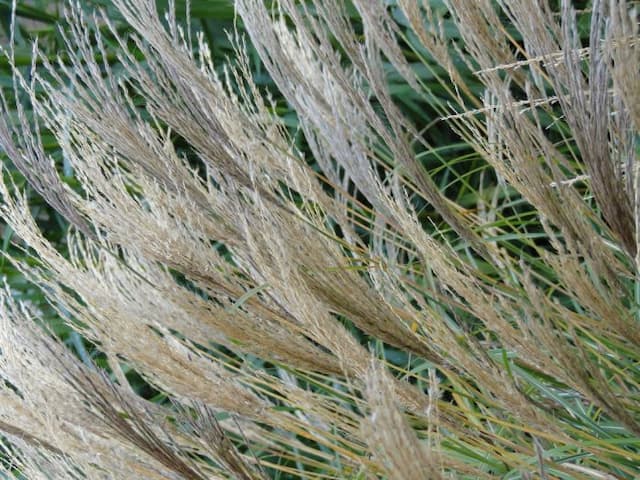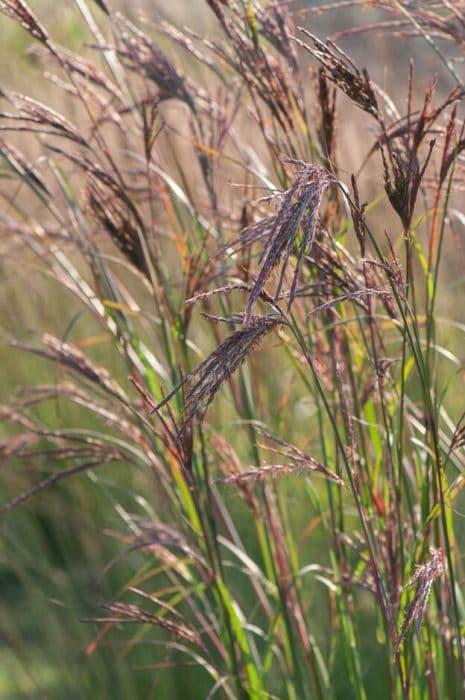Hameln Fountain Grass Pennisetum alopecuroides 'Hameln'











ABOUT
Pennisetum alopecuroides 'Hameln', commonly known as Hameln fountain grass, is an ornamental grass that is valued for its graceful, fountain-like form and fluffy, bottlebrush-like flowers. This grass has a clumping habit, producing a rounded shape that looks soft and lush. The leaves of Hameln fountain grass are narrow and arch elegantly from the center of the clump, lending the plant its fountain-like appearance. They are typically green in color, sometimes showing hints of yellow or gold, especially in autumn. During the summer and into fall, Hameln fountain grass produces showy flower spikes that rise above the foliage. These flower spikes, or plumes, are soft and feathery, starting off with a light green or creamy tan color and eventually turning to a buff or beige hue as they mature and dry. The plumes are dense and cylindrically shaped, giving them the appearance of a bottlebrush. They can catch the light beautifully and often sway in the breeze, adding to the plant's visual interest and graceful movement. The overall texture of Hameln fountain grass contributes significantly to its appeal in the landscape. It provides a soft, fine-textured element, which can contrast nicely with larger-leaved plants or stiffer, more architectural features. This plant is often used as a focal point or as part of a border, and its flowing form can also help to create a natural, informal look in gardens or landscaped areas. With its attractive seasonal changes and movement, Hameln fountain grass is a versatile and visually appealing plant.
About this plant
 Names
NamesFamily
Poaceae.
Synonyms
Hameln Fountain Grass, Dwarf Fountain Grass, Hameln Dwarf Fountain Grass, Chinese Fountain Grass.
Common names
Cenchrus alopecuroides, Pennisetum alopecuroideum, Pennisetum compressum, Pennisetum japonicum.
 Toxicity
ToxicityTo humans
The Hameln Dwarf Fountain Grass is not known to be toxic to humans. It poses no significant risk if ingested and does not typically cause any symptoms of poisoning.
To pets
The Hameln Dwarf Fountain Grass is also not considered toxic to pets. It is generally safe if pets come into contact with or ingest parts of the plant, and it does not commonly result in symptoms of poisoning. However, as with the consumption of any non-food plant, ingestion might potentially cause mild gastrointestinal upset in some animals due to the physical nature of the plant matter.
 Characteristics
CharacteristicsLife cycle
Perennials
Foliage type
Deciduous
Color of leaves
Green
Flower color
Tan
Height
2 feet (0.61 meters)
Spread
2 feet (0.61 meters)
Plant type
Grass
Hardiness zones
5
Native area
Asia
Benefits
 General Benefits
General Benefits- Low Maintenance: The Hameln fountain grass requires minimal care once established, making it a convenient choice for gardeners of all levels.
- Drought Tolerance: It is relatively drought-tolerant, which is beneficial for water conservation and in regions with water restrictions.
- Aesthetic Appeal: With its feathery plumes and arching foliage, the Hameln fountain grass adds texture and movement to the landscape.
- Seasonal Interest: It provides visual interest throughout the year, especially in autumn when its foliage changes color.
- Wildlife Attraction: The seeds from its plumes attract birds, while the grass provides cover for various small wildlife.
- Erosion Control: Hameln fountain grass can help prevent soil erosion with its dense growth habit and extensive root system.
- Adaptability: It can grow in a variety of soil types, from well-drained sandy soils to clay, making it versatile for different garden settings.
- Borders and Accents: It is often used to create borders, as a groundcover or as an accent plant in gardens and landscapes.
- Easy Propagation: Hameln fountain grass can be easily propagated by division, allowing gardeners to spread its beauty throughout their gardens without additional cost.
- Container Gardening: It grows well in containers, which is great for patios, balconies, and other small spaces.
 Medical Properties
Medical PropertiesThis plant is not used for medical purposes.
 Air-purifying Qualities
Air-purifying QualitiesThis plant is not specifically known for air purifying qualities.
 Other Uses
Other Uses- Floral Arrangements: The fluffy, cream-colored seed heads of Hameln grass are often used in dried floral arrangements, lending texture and movement to bouquets.
- Erosion Control: The dense, fibrous root system of this ornamental grass helps stabilize slopes and prevent soil erosion.
- Aquatic Plant Substitute: In water garden designs, Hameln grass can mimic the look of reeds or other aquatic plants while planted in dry land around the water feature.
- Noise Reduction: When planted in mass, the thick growth of Hameln grass can help dampen and absorb sound, making it ideal for use near busy roads or in urban environments.
- Fodder: While not a primary use, the grass can be a source of fodder for livestock in certain conditions, though there are better-suited species for grazing.
- Photography: The distinctive seed heads and foliage of Hameln grass provide a picturesque element for photography enthusiasts, especially during the autumn golden hour.
- Privacy Screening: Taller varieties of the grass planted closely together can form a semi-transparent screen, providing privacy in gardens and outdoor spaces.
- Garden Borders: The uniform and tidy mounding habit of Hameln grass makes it an excellent choice for creating defined edges along garden beds or walkways.
- Wildlife Habitat: The dense foliage provides shelter for small wildlife, like birds and insects, which can encourage biodiversity in a garden setting.
- Winter Interest: In colder climates, the dried foliage and seed heads of Hameln grass remain upright throughout the winter, adding texture and interest to the dormant garden landscape.
Interesting Facts
 Feng Shui
Feng ShuiThe Fountain Grass is not used in Feng Shui practice.
 Zodiac Sign Compitability
Zodiac Sign CompitabilityThe Fountain Grass is not used in astrology practice.
 Plant Symbolism
Plant Symbolism- Resilience: As a grass that adapts well to various environments, the 'Hameln' dwarf fountain grass symbolizes resilience and the ability to thrive in diverse conditions.
- Flexibility: The flowing nature of its foliage and the way it sways with the breeze represent flexibility and the idea of going with the flow.
- Privacy: Often used as a hedge or screening plant, it can symbolize the need for privacy or creating personal boundaries.
 Water
WaterThe fountain grass should be watered deeply once a week, providing about 1 to 1.5 inches of water each time to saturate the root zone. During hot, dry spells, you may need to water twice a week. When established, fountain grass is fairly drought-tolerant, requiring less frequent watering; however, consistent moisture yields the best growth and flowering results. Prefer a deep and infrequent watering method over shallow, frequent waterings to encourage a strong root system. Use a soaker hose or drip irrigation to apply water directly to the soil around the plant, which also helps to minimize leaf wetness and related disease issues.
 Light
LightFountain grass thrives in full sun, so it should be planted in a location that receives at least 6 hours of direct sunlight each day. The plant can tolerate partial shade, but too much shade can result in a less vigorous plant with fewer plumes. The best spot for fountain grass is a sunny border or open area where it receives ample light throughout the day, which will promote the densest growth and most prolific blooming.
 Temperature
TemperatureFountain grass prefers warm temperatures and does best in USDA zones 5 through 9. It can tolerate temperatures down to about -10 degrees Fahrenheit but may die back to the ground in colder climates. The ideal temperature range for fountain grass is between 60 and 90 degrees Fahrenheit. It is heat tolerant and can survive high summer temperatures well above 90 degrees Fahrenheit as long as it is well-watered.
 Pruning
PruningFountain grass should be pruned back in late winter or early spring before new growth begins, cutting the plant down to about 3 to 4 inches from the ground. This helps to remove old, brown foliage and makes way for fresh, new growth. Pruning is also necessary to maintain its shape and promote a healthier, denser plant. Annually pruning fountain grass encourages more vigorous growth and better flowering in the upcoming season.
 Cleaning
CleaningAs needed
 Soil
SoilThe best soil mix for Hameln Fountain Grass should be well-draining, loamy, and rich in organic matter. A mix of two parts garden loam, one part peat moss, and one part perlite or coarse sand would be ideal. This grass prefers a soil pH close to neutral, ranging from 6.0 to 7.0.
 Repotting
RepottingHameln Fountain Grass, being a perennial grass, typically does not require repotting as it is usually grown outdoors. However, if grown in a container, it may need repotting every 2 to 3 years to refresh the soil and provide room for growth.
 Humidity & Misting
Humidity & MistingHameln Fountain Grass is versatile and does not require specific humidity levels. It thrives in the ambient humidity of most temperate outdoor environments.
 Suitable locations
Suitable locationsIndoor
Place in bright light and don't oversaturate soil.
Outdoor
Full sun, well-draining soil, divide every 3-5 years.
Hardiness zone
5-9 USDA
 Life cycle
Life cycleThe life of Pennisetum alopecuroides 'Hameln', commonly known as Hameln fountain grass, begins with germination, where the seed requires warm temperatures and adequate moisture to sprout. After germination, it enters a period of vegetative growth, developing a clump of grass-like foliage and establishing a robust root system. As the plant matures, it progresses to the flowering stage, usually in late summer to early fall, producing bottlebrush-shaped inflorescences that are tan to cream in color. Following pollination, which is often aided by the wind, the grass sets seed, completing its reproductive cycle. In winter, the plant typically becomes dormant, with the foliage browning, although it remains ornamental even in dormancy. With the return of warmer weather in spring, the plant will resume growth, often reseeding itself if conditions are favorable, or it can be rejuvenated through division to maintain its vigor.
 Propogation
PropogationPropogation time
Late Spring to Early Summer
Fountain Grass (Pennisetum alopecuroides 'Hameln') is most commonly propagated through division. This process is ideally carried out in the spring when the grass is just beginning to break dormancy and showing signs of new growth. To propagate by division, carefully dig up an established clump and gently separate it into smaller sections, each with a portion of roots and shoots. These individual sections can then be replanted immediately. It’s important to water the new divisions thoroughly after planting to help them establish. Division not only helps in propagating the plant but also rejuvenates older clumps that may have become woody and less vigorous at their center.









